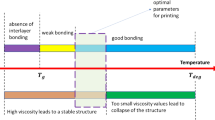Abstract
The strength of polyethylene autohesion joints obtained by simultaneous deformation is compared with that of compressed specimens of monolithic LPP. The probable mechanisms of polyethylene autohesion under these conditions are discussed.
Similar content being viewed by others
Literature cited
R. K. Glude, Mekh. Polim. [Polymer Mechanics], No. 4, 574 (1966).
R. A. Baltenas and L. A. Igonin, DAN156, 3 (1964).
G. M. Bartenev and Yu. S. Zuev, Strength and Fracture of High-Elastic Materials [in Russian], Moscow-Leningrad (1964).
L. E. Nielsen, Mechanical Properties of Polymers, New York (1962).
N. N. Bezukhov, Theory of Elasticity and Plasticity [in Russian], Moscow (1953).
Low-Pressure Polyethylene [in Russian], Goskhimizdat, Leningrad (1960).
N. K. Baramboim, Polymer Mechanochemistry [in Russian], Gostekhizdat (1961).
V. A. Kargin and G. L. Slonimskii, Brief Outline of Polymer Physicochemistry [in Russian], Moscow (1967).
Additional information
Institute of Polymer Mechanics, Academy of Sciences of the Latvian SSR, Riga. Translated from Mekhanika Polimerov, Vol. 4, No. 4, pp. 656–660, July–August, 1968.
Rights and permissions
About this article
Cite this article
Glude, R.K. Polyethylene autohesion under simultaneous deformation. Polymer Mechanics 4, 507–510 (1968). https://doi.org/10.1007/BF00855762
Received:
Issue Date:
DOI: https://doi.org/10.1007/BF00855762




